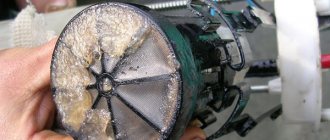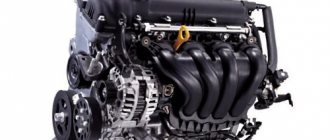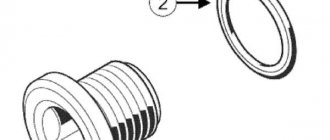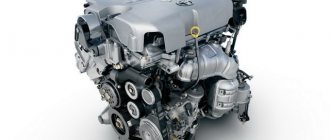Diesel fuel and its types
Car enthusiasts are aware that cars with diesel engines start up much worse in winter than their gasoline counterparts. This is due to the fact that ignition of diesel fuel requires special conditions: in severe frosts, diesel fuel thickens, and its spraying by nozzles becomes quite problematic.
Today there are 3 types of diesel fuel in use:
- summer, the use of which is permissible at air temperatures above 0 degrees Celsius;
- winter (you can safely refuel your car even at -30 degrees);
- arctic, used in the far north.
The main problems arise due to the fact that motorists use inappropriate diesel fuel: in winter they fill the car with fuel for above-zero temperatures.
Is it necessary to warm up a diesel engine with a turbine?
How does the motor work? After the ignition is started, fuel enters the combustion chamber, from which a combustible mixture is formed. At this moment, a spark is produced at the spark plug, igniting this mixture. As a result of ignition, the pressure increases, as a result of which the piston group of the engine begins to work.
If the engine is not running, then cold oil is in the crankcase: it enters the engine channels only after it is started. During ignition, friction occurs between parts, which causes wear. As engine components heat up, friction decreases.
Is it necessary to warm up a diesel engine? Parts in an unheated engine wear out at a faster rate, so if you want to extend the life of the engine, it is necessary to warm it up.
But there are opposing opinions on this matter. Some car enthusiasts believe that modern engines do not need to be warmed up, others say that the engine should be warmed up thoroughly, and some are sure that warming up is needed, but only for a short time.
A number of automobile companies claim that the engines they produce do not need to be warmed up, however, these words are dictated not by practical considerations, but by fines in some European countries established for warming up.
Features of diesel engine operation in winter
PREPARATION OF DIESEL FOR WINTER OPERATION:
- In winter, work processes in a diesel engine become noticeably more complicated. Fuel that is more viscous due to low temperature is less well atomized through the nozzle, and the atomized fuel immediately “settles” in the form of dew on the walls of the combustion chamber. Its evaporation from the walls is difficult due to the low temperature. Cold air entering the cylinders only aggravates the situation, but its temperature at the end of compression should be higher than the self-ignition temperature of diesel fuel. Thickened oil should also be added here, the increased resistance of which must be overcome during startup.
The starter and battery must develop enough power to force the crankshaft to “push” the pistons at high frequency, and diesel fuel must not turn into “jelly” and crystallize at low temperatures.
- Be sure to check the electrolyte level. In the summer this is somehow forgotten, and sometimes it turns out that the battery is dry, like a dry well.
- Particular attention should be paid to the output terminals of the battery and starter, as well as the wire tips, which must be cleaned from oxidation. At low temperatures, the capacity of the battery for natural reasons is significantly reduced, and high transient resistances in electrical circuits are added to this. It wouldn’t hurt to coat the terminals with a layer of grease to somehow protect them from the action of salt, which is abundant on the roads in winter.
- In the power system, sediment should be drained from the filter and fuel tank.
- If a diesel engine has been running with “smoke” in the summer, it makes sense to check and, if necessary, adjust the fuel injection advance angle. Failure of this parameter can make it very difficult to start a cold engine. If you lack experience, you should not adjust the injection angle yourself; it is better to contact a service station.
- Consider maybe removing the mesh from the intake in the fuel tank. This mesh is a “wonderful” traffic jam organizer. As if you didn’t have to use a compressor to blow the fuel line of the tank in the opposite direction.
- For cars with a mileage of over 100,000 km, winter starting can be greatly complicated by insufficient compression in the diesel cylinders. Worn piston rings and cylinder liners are usually to blame for this. But what can you say if the owners put off repairing the piston group until the last moment. It is advisable to “make life easier” for the starter and battery by using oils with reduced viscosity according to SAE 5W-30.
Fans of aerosol cans with flammable compounds for starting engines are asked to remember: diesel engines can suffer greatly from an overdose. Even 1 cm 3 of such a composition can break all the pistons - the resulting loads are too great (the composition will ignite too early).
02:0625.08.2016
To promote a diesel engine, we recommend silicone lubricant instead of ether.
Details about the product: In warm weather, we recommend using silicone lubricant to test run a diesel engine with a fuel supply problem (due to faulty fuel equipment). Its ignition temperature is higher than that of ether, so it does not ignite prematurely. In winter, using silicone grease for starting will not work.
01:1029.12.2015
When starting a diesel engine with ether, turn off the glow plugs
Renault Kangoo 1.9 with a vortex chamber engine: the engine did not start and the client decided to inject ether into the air blower. Due to the glow plugs being turned on, the ether exploded in the air filter. Use ether only when your starter turns well and the glow plugs are turned off!
CHECKING DIESEL GLOW PLUGS
- So, glow plugs must provide the combustion chamber with the temperature necessary for normal mixture formation and self-ignition. It must be said that the spark plugs cope with their task quite effectively, especially on vortex and pre-chamber diesel engines.
- For a diesel engine, winter begins when the thermometer drops to + 5 °C. Only up to this air temperature is it possible to somehow start a diesel engine with non-working glow plugs. At lower temperatures this is impossible, even if only one spark plug is acting up.
- The operation of the glow plugs is “signaled” by an indicator on the instrument panel, which should light up and go out after a while, as if indicating that the air in the combustion chamber is ready to receive a portion of diesel fuel. Experience shows that you should not trust this indicator. It can light up even if the fuse has blown and the spark plug control unit relay has not activated.
- As for the reliability of spark plugs, after 5 years of operation the internal filament coil may burn out. To check, the spark plug should be unscrewed from the head, the voltage from the “plus” of the battery should be applied to the spark plug terminal, and the “minus” voltage to the housing. With a working spark plug, the glow tube heats up immediately. After 7 seconds it becomes hot and begins to glow, otherwise the candle should be replaced.
- While glow plugs on passenger diesel engines are found everywhere, more efficient pre-heaters that are so necessary in winter are extremely rare. And this is understandable, because most diesel foreign cars are designed for the climate of Central Europe and are absolutely not adapted to our winters. Cars from Scandinavia, as well as German and French ones, aimed at our market, are much better prepared for operation in winter conditions and have a number of “highlights” in their design in this regard, including pre-heaters . They may be installed at an additional cost, but when paired with a timer, such a heater works wonders - the car “comes to life” as if an alarm clock rings. When the owner arrives, everything is ready for the trip: the engine is warm, the interior is warm, there is no need to scrape ice off the windows, etc.
At temperatures below 0°C in summer diesel fuel (DF), crystals of paraffin hydrocarbons are formed
, which grow together and clog fuel filters and fuel lines. Winter diesel fuel does not differ from summer diesel fuel either in color or smell. So it turns out that only God and the gas station attendant know what is actually poured into the car’s tank. Since our climate is variable, there is no reason for gas stations to purchase expensive winter diesel fuel. In order not to rely on luck, it is necessary to add depressant additives (“antigel”) in the proportion of 2-3 ml of additive per 1 liter of diesel fuel
It is necessary to add at positive + temperature of the fuel, the higher the temperature, the better the additive will be mixed in the fuel and the lower the freezing point will be. At the gas station, the fuel is not heated, so we recommend filling a 20 liter canister with diesel fuel, adding the additive in proportion to the entire tank, heating it to 50°, and going to the gas station. Fill it first and refuel until full, so that the proportion of heated diesel fuel is at least 30% of the total volume of the tank. To be completely sure, we recommend installing a fuel heater in front of the fuel filter. Thanks to additional heating it improves; fluidity of diesel fuel, filtration, dirt separation; operability of fuel equipment; the combustion process is softened (due to the entry into the combustion chamber of not icy fuel, but warm fuel capable of rapid and complete combustion), directly related to engine life; efficiency of the engine itself. If the fuel is already frozen, then pouring “antigel” into the already thickened (frozen, frozen) diesel fuel is absolutely useless!!! The car needs to be transported to a warm garage, warm up the fuel tank, add “antigel” (in proportion), fill the full tank with diesel fuel, warm up the fuel filter (see fig). Bleed the fuel system from air and start the engine.
The AGA company conducted testing of diesel fuel depressant additives offered on the market at the Oil Refining Research Institute (Russia). The tests were carried out using standard “L” (summer) diesel fuel.
| Results of tests of depressant additives (anti-gels) carried out at the Oil Refining Research Institute (Russia) | |||
| A drug | Ratio | Tr, °C | Tf, ° C |
| Without additive | — | -17 | -5 |
| Gunk | 1:500 | -28 | -6 |
| Liqui Moli | 1:300 | -30 | -16 |
| Wynn's | 1:500 | -25 | -11 |
| Aspect D | 1:500 | -30 | -12 |
| Jet 60 | 1:200 | -27 | -10 |
| SUPERANTIGEL HG | 1:500 | -39 | -16 |
| SUPERANTIGEL HG | 1:300 | -41 | -19 |
- Tr – solidification temperature (gelation) of the fuel – the temperature at which the fuel does not move during the cooling process in a special device at an angle of 45° for one minute. This indicator serves to assess the possibility of refueling, transporting, draining and transferring diesel fuel.
- Tf - the limiting filterability temperature is the temperature at which fuel, when cooled under certain conditions, stops passing through a special fuel filter (the temperature at which the fuel filter becomes clogged with paraffins).
- If it is not possible to pour antigel, or you want to play it safe, we recommend heating the fuel intake in the tank. The simplest and most effective way is to install an electric fuel heater on the fuel return line that returns to the tank. Hot fuel heats the fuel intake in the tank, preventing it from freezing
The real tests for a diesel engine begin when the temperature outside is below -20 °C. Think about it: maybe it would be better to leave your “four-wheeled friend” alone and get to work by public transport?
PS And one more thing! Do not pour hot water on the engine! To warm up the engine, you need to pour a barrel of hot water on it, and the water from the kettle will immediately get under the timing belt and instantly freeze on the icy metal. At the first start, the belt slips 100%! If you want to warm up something, then pour it on the intake manifold, or better yet, warm up the engine with a hot air gun.
How to properly warm up a diesel engine?
The warming up procedure is simple and will not take much time, but will have a positive effect on the service life of the engine.
There are two ways to warm up:
- After the car has been started, you need to let the engine idle for about 3 minutes. Then you can start driving, but during this time the engine and all its components will not be able to fully warm up, so for 10 minutes it is better not to give the load above 2500 rpm.
- Do not start driving until the temperature, according to the sensor, rises to 60 degrees in winter and 50 in summer. However, even after this, the first time you should move smoothly, since a not fully warmed-up engine consumes more fuel.
Concern for the environment in many countries has led to the fact that warming up a gasoline or diesel car is prohibited by law. Moreover, in the operating manuals, the car manufacturers themselves recommend starting to drive immediately and warming up the engine while driving. It is quite obvious that the service life of the units was simply relegated to the background, since in developed countries the model range is updated approximately every 3-4 years, and during this period (100-150 thousand km) the engines are well maintained.
On the topic: is it necessary to warm up a cold engine in winter and how to do it?
The main reason is simple - any oil thickens in the cold, and when it reaches a certain temperature it can completely lose its fluidity:
- Mineral – at -20…25 °C.
- Synthetic – at 45…45 °C.
As a result, the friction units operate “dry”, the level of mechanical losses increases, and this certainly requires additional fuel costs. However, when will warming up a cooled car engine in winter reach the optimal temperature? If you start the engine and immediately start moving or warm it up in place? Let's test three heating algorithms:
- The classic one is to warm up the engine and then drive.
- Modern - started it up and went.
- Mixed - start, let the internal combustion engine run for 3-5 minutes, and heat it to operating temperature while driving.
For research, a new foreign car from Europe with a 1.6 liter Euro-4 engine was taken.
Classic version
After starting, the tachometer shows 1,200 revolutions, while the fuel consumption is 2.5 l/h. After 60 seconds, consumption dropped to 1.9 liters, and after 10 minutes - to 0.85 liters. The antifreeze temperature reached only 50 °C.
After another 10 minutes, the flow rate dropped to 0.8 l/h, and the coolant temperature remained at 55 °C. We start driving in a fixed mode, reaching 50 km/h, fuel consumption is 6.5 liters per 100 km. As a result, about 0.8 liters of gasoline were spent on heating.
Modern version
Almost all current car manufacturers recommend starting to drive immediately after starting the internal combustion engine. This is not good for the car, but what automaker looks beyond the warranty period. So, for starters, fuel consumption is 10 liters. After 40-50 seconds it dropped and stopped at 6.7 liters.
As a result, about 0.5 liters of fuel were consumed, plus 20 minutes of personal time were saved. Optimization is obvious, but how justified it is over the long term is a question.
Mixed option
After starting, the engine ran for 5 minutes while the glass was cleared of ice. The movement began at a flow rate of 1.4 l/h at idle. At the start of the run the figure was 7.5 liters per 100 km, and at the end – 6.5. As a result, 0.6 liters were consumed, which is better than the first option, but slightly worse than the second.
Combustion of fuel
According to manufacturers, the fuel injection systems of modern diesel engines allow you to move immediately after starting the engine; diesel fuel is atomized in the cylinders in such a way that diesel fuel does not wash away the oil film from the surface of the liners.
One way or another, at low air temperatures very often diesel fuel becomes more viscous and its fluidity decreases. The performance of a diesel engine is also affected by the cetane number of diesel fuel, the presence of various impurities and additives, as well as the overall quality of the fuel. Pre-heaters, glow plugs and other solutions are designed to make starting easier, but the efficiency of fuel atomization by diesel injectors still depends on the internal combustion engine reaching operating temperatures. Additionally, it is worth considering that the supply of cold outside air leads to a general decrease in the temperature inside the cylinder.
For this reason, a diesel engine in winter needs a certain warm-up before driving and increasing loads. As the temperature rises, fuel combustion in the chamber becomes uniform and complete.
Is it possible to use the machine at temperatures of minus 30 or more?
Whether it is worth using a car in extreme frosts is decided by each car owner individually. Some people constantly use their car in winter, regardless of the weather outside, while others still decide to refuse to travel in such hellish cold. It should be said that at extreme negative temperatures, all systems and components of the vehicle are subject to increased load. Therefore, even if the car is thoroughly warmed up before driving, increased wear is still observed, which can lead to failure of various components and assemblies. Especially in winter, at temperatures below minus 30, the car’s engine, battery and various suspension elements, which use rubberized parts and gaskets, will suffer.
Cylinder piston group and crankshaft
It is worth considering that warming up of a diesel engine is not uniform. Some parts heat up faster, others still remain cold. The internal combustion engine elements are made of metal and aluminum alloys (crankshaft, cylinders, pistons, shafts, etc.). As you know, when heated, the body expands, and the heating time and expansion coefficient depend on the material of manufacture.
It turns out that only after the motor reaches operating temperatures are optimal thermal clearances established and the rubbing pairs are properly lubricated. For this reason, immediate start of movement and additional loads on a cold engine reduce its service life.
Heating the engine oil
The design features of diesel engines, compared to gasoline engines, require reduced gaps that are present between the cylinder wall and the piston. Diesel-fuelled internal combustion engines have a high compression ratio, which also means serious loads on the cylinder-piston group.
Part wear is minimized by engine oil. During the cold season, the lubricant in the engine crankcase thickens. After inactivity, only a small oil film remains on the cylinder walls and surfaces of rubbing parts.
After a cold start, the effective operation of the lubrication system begins from the moment the internal combustion engine reaches operating temperature (the oil finally liquefies, heats up and begins to operate under optimal conditions). Turbocharged diesel engines additionally require a high-quality supply of heated engine oil to lubricate the turbocharger. The resource of a diesel engine turbine directly depends on this. It is logical that the oil needs to be warmed up a little at idle, and when you start driving, do not subject the engine and turbine to loads until they are completely warmed up.
conclusions
So, the answer to the question of whether it is necessary to warm up the engine before driving is still positive: yes, warm it up! But not for long, especially if it is a modern vehicle with an injection engine. Long idling harms the engine no less than starting from a standstill “from a cold state,” and a short warm-up with a leisurely and careful drive without “spin-up” to high speeds will help the engine come out faster to optimal mode, saving resources. It is advisable to warm up old carburetor engines longer, until they fully reach the operating temperature zone.
You should not turn on the heater at the same time as starting the engine in the cold; this will significantly increase the total warm-up time. A good help for the car owner will be an engine pre-heating system, launched according to a schedule or remotely by pressing a button on the key fob. It will ensure that the car is ready to move, for example, while the driver is preparing to leave the house, thus reducing the time spent warming up the engine.
For diesel cars, be sure to use diesel fuel appropriate for the season.
What's the result?
To answer the question of how and how long to warm up a diesel engine at idle in winter, it is necessary to take into account the specifics of engines of this type. First of all, a diesel engine has high efficiency; it is difficult to warm up such an engine at idle speed in cold weather. The second nuance is the fact that the operation of the internal combustion engine in idle mode (minimum speed) means low oil pressure in the engine lubrication system and refers to severe operating conditions.
After such warming up, you can smoothly start driving in a lower gear and at low speeds. In the warm season, no more than 1-2 minutes of warming up the diesel engine before driving will be enough, and during the ride the engine will quickly and completely warm up.
Finally, let’s add that not only the engine, but also the transmission requires warming up. Automatic transmissions of the torque converter type, which are also filled with oil, are especially sensitive to “cold” loads. Special transmission oils in automatic transmissions act not only as a lubricant, but also as a working fluid, which is supplied to the gearbox components under pressure.
How to properly warm up a car engine. Features of warming up engines with a carburetor, injector and installed gas equipment, as well as diesel engines.
What temperature of a diesel unit is considered optimal. Diesel does not warm up, possible malfunctions and consequences of driving on a cold engine.
Causes of vibration and unstable operation of a diesel engine in idle mode. Possible causes and fault diagnosis.
Causes of difficult “cold” starting of a diesel engine. Compression, glow plugs, diesel injectors, injection pump, paraffin or water in the fuel system.
The engine does not reach operating temperature, the engine temperature arrow does not rise during warm-up or falls while driving: causes of the malfunction.
Starting the engine of a car that has been standing idle for a long time. What you need to check before starting the engine: fluids, transmission, brakes.
Many novice motorists have a question about whether it is necessary to warm up the diesel engine before driving. And if such a need is obvious with carburetor power plants, then when using modern gasoline and diesel engines the situation for drivers is not so clear.
What does engine heating look like in winter conditions?
The power unit can be considered heated only when all process fluids and parts reach operating temperatures. The coolant warms up the fastest, as evidenced by the position of the arrow on the instrument panel. At the same time as the antifreeze, the upper part of the internal combustion engine is heated. Next, heating proceeds in the following sequence:
- Oil in the pan.
- Neutralizer.
During the process of heating the engine, many novice motorists pay attention to the increase in fuel consumption and mistakenly believe that the ECU is to blame. However, this is not the case, and further heating proves this.
Why do you need to warm up the engine?
All vehicle operating manuals clearly indicate the need to warm up the engine while driving. However, it is not. Manufacturers make these recommendations to reduce emissions from their vehicles. But at the same time, the engine itself wears out faster. On the technical side, before a trip, it is necessary to warm up the power plant at idle speed. This is also required for any gearbox for its correct functioning.
There is a common misconception among drivers that good motor oil provides effective protection to all rubbing elements of the power plant, regardless of the outside temperature. However, in severe frosts, lubricants lose their properties, so they also need to be warmed up.
What auto mechanics say at service stations
Many experienced auto mechanics adhere to the theory that it is still necessary to warm up the engine, especially in cold weather. We will tell you why they think this way further.
But there is a category of masters who are indifferent to this and recommend that drivers not waste either time or fuel on this dubious process.
Supporters of engine warming up explain their position based on the opinion of car creators, i.e. engineers.
The opinion is that ? All engine wear occurs when it is started before a trip, and this figure especially increases if the engine is not warmed up in cold weather.
Adherents of the “sit down and go” principle justify their position by the fact that the engines on modern cars have a long service life, so until the engine fails, the rotten car can be thrown away for scrap metal a long time ago.
By the way, residents of America and European countries think the same way; rarely anyone in these countries warms up the engine.
Again we get two camps, then where is the truth? Let's figure it out.
How to warm up a diesel
The main difference between warming up a diesel unit and a gasoline unit is that the former’s temperature rises much more slowly. After 5-10 minutes of idling the engine, you can start moving at 15-20 degrees at low speeds and warm up the engine while driving. In severe frosts, diesel fuel may completely crystallize, making it impossible to start the engine. As a result, even if the car starts, it will stall after driving only a couple of tens of meters. This is due to the use of residual diesel fuel in the system, which has not frozen.
Depending on the outside temperature, the time during which the power plant must idle to warm up is determined. If this is not done, then negative consequences are possible due to increased wear of the rubbing elements, as well as strong vibration.
Warm-up rules
Car owners have empirically derived several rules regarding how long to warm up the engine:
- at temperatures from 0 to +5 degrees, it is enough to warm up the engine for 1-2 minutes. In such conditions, the glass does not have time to ice up, so there is no need to wait for the stove to reach operating temperature in order to heat the interior;
- From 0 to -10 it is worth warming up the engine for about 3 minutes. Technical fluids and engine metal will warm up to the minimum permissible temperatures for driving, but it may take more time to heat the interior;
- from -10 to -20 – it should take 3-5 minutes to warm up the engine. The car windows can become frozen, and they should also be warmed up. Therefore, after warming up the engine, you need to turn on the heater and provide heat in the cabin to defrost the windows.
Important: do not turn on the heater at the same time as starting the engine! This will only increase the overall warm-up time.
- at temperatures below -20, you need to warm up the engine for 5 minutes, the specific time is determined individually, depending on the age and condition of the car. The more powerful the stove and the newer the car, the faster it will warm up. On average, the engine heats up in about 5 minutes, the interior in 10.











